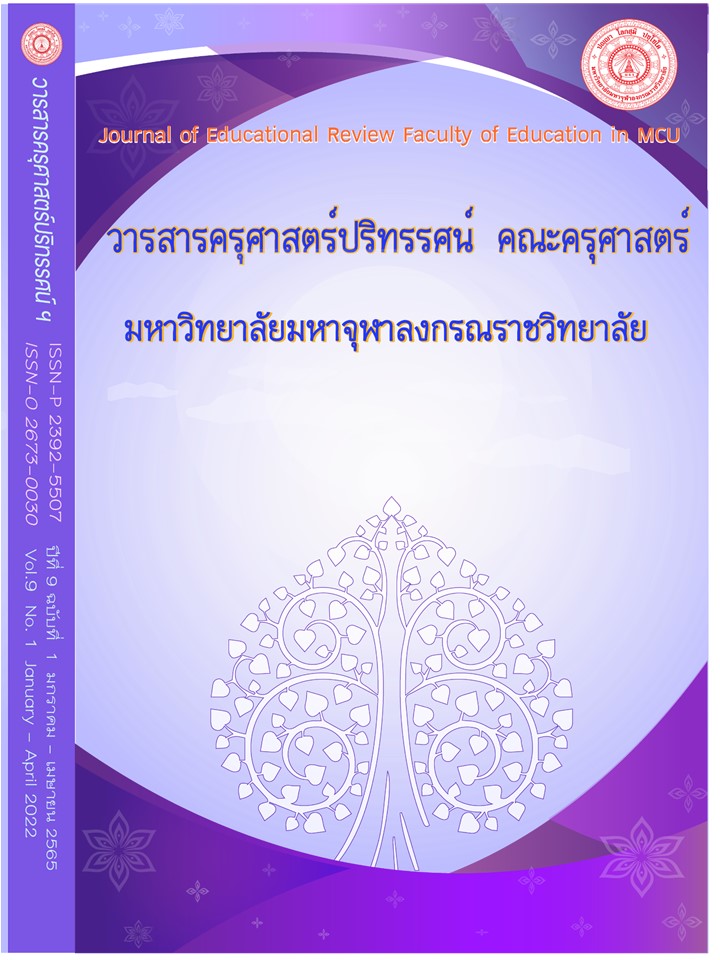RISK MANAGEMENT STRATEGIES BASED ON PHYSICAL DHARMA PRINCIPLES FOR EDUCATIONAL INSTITUTIONS IN THE 4.0 EEA
Main Article Content
Abstract
This article presents risk management strategies based on Pala Dhamma principles for educational institutions. In the 4.0 era, which is change management since the reform strategic organization up to the risk management process. The importance of change management from the organizational change at the strategic level to process level. "Risk Management" is therefore an element that the importance of good corporate governance in dealing with changes that occur so that the organization can move forward jump to the mission to achieve the specified goals. Therefore, the management must know how to prevent risks that will occur in the school administration, manage risks effectively for the organization face the risk situation to an acceptable level as well as taking into account the achievement of objectives and the goals of the organization are important. A management approach that is feasible to forecast and reduce the negative effects of uncertainty that will happen to the organization but self-management, people management, and administration will produce good results and effective. There must be Buddhist principles applied to the changing situation. The Pala Dhamma IV, which are the principles of Buddhism in modern society consisted of 1) Panya Pala (wisdom) and strength, the power of knowledge, wisdom, knowledge of self, 2) Viriya Pala (effort), strength diligence or a diligent person must have strong willpower and have the courage to make decisions, 3) Anavajja Pala, the power of a work without penalty or damage, 4) Sanghaha strength of synthesis or human relations.
Article Details

This work is licensed under a Creative Commons Attribution-NonCommercial-NoDerivatives 4.0 International License.
ทัศนะและความคิดเห็นที่ปรากฏในบทความในวารสารฉบับนี้ถือเป็นความรับผิดชอบของผู้เขียนบทความนั้นเพียงผู้เดียว และไม่ถือเป็นทัศนะและความรับผิดชอบของกองบรรณาธิการ
กองบรรณาธิการขอสงวนสิทธิ์ในการคัดเลือกบทความลงตีพิมพ์และจะแจ้งให้เจ้าของบทความทราบหลังจากผู้ประเมินบทความตรวจอ่านบทความแล้ว
ต้นฉบับที่ได้รับการตีพิมพ์ในวารสารครุศาสตร์ปริทรรศน์ คณะครุศาสตร์ มหาวิทยาลัยมหาจุฬาลงกรณราชวิทยาลัย ถือเป็นกรรมสิทธิ์ของคณะครุศาสตร์ มหาวิทยาลัยมหาจุฬาลงกรณราชวิทยาลัย ห้ามนำข้อความทั้งหมดหรือบางส่วนไปพิมพ์ซ้ำ เว้นเสียแต่ว่าจะได้รับอนุญาตจากมหาวิทยาลัยฯ เป็นลายลักษณ์อักษร
References
เจริญ เจษฏาวัลย์. (2547). การบริหารความเสี่ยง. กรุงเทพมหานคร: โรงพิมพ์จุฬาลงกรณ์มหาวิทยาลัย.
ธนรัตน์ แต้วัฒนา. (2550). คู่มือการบริหารความเสี่ยง. กรุงเทพมหานคร: มหาวิทยาลัยศรีนครินทร์วิโรฒ.
ธวัชชัย สุขสีดา. (2564). การสื่อสารการตลาดแบบบูรณาการที่ส่งผลต่อการตัดสินใจเลือกศึกษาต่อในสถาบันอุดมศึกษาเอกชนในยุควิถีใหม่ . ดุษฎีนิพนธ์ปรัชญาดุษฎีบัณฑิต. มหาวิทยาลัยธุรกิจบัณฑิต.
พระพรหมคุณาภรณ์ (ป. อ. ปยุตฺโต). (2556). พจนานุกรมพุทธศาสตร์ ฉบับประมวลศัพท์. พิมพ์ครั้งที่ 21. กรุงเทพมหานคร: ผลิธัมม์.
พระพรหมคุณาภรณ์ (ป. อ. ปยุตฺโต). (2556). พจนานุกรมพุทธศาสตร์ ฉบับประมวลธรรม. พิมพ์ครั้งที่ 25. กรุงเทพมหานคร: ผลิธัมม์.
พระราชวรมุนี (ประยูร ธมฺมจิตโต). (2541). คุณธรรมสำหรับนักบริหาร. พิมพ์ครั้งที่ 4. กรุงเทพมหานคร: วิทยาลัยข้าราชการพลเรือน สถาบันพัฒนาข้าราชการพลเรือน.
มหาวิทยาลัยจุฬาลงกรณราชวิทยาลัย. (2539). พระไตรปิฎกฉบับภาษาไทย ฉบับจุฬาลงกรณราชวิทยาลัย. กรุงเทพมหานคร: โรงพิมพ์มหาจุฬาลกรณราชวิทยาลัย.
ว่าที่ ร.ต.สมชาย เพชรนุ่ม. (2563). การบริหารความเสี่ยงของผู้บริหารโรงเรียนมัธยมศึกษาในจังหวัดกระบี่. สารนิพนธ์ศึกษาศาสตรมหาบัณฑิต. มหาวิทยาลัยบูรพา.
สมศักดิ์ บุญปู่. (2557). พลธรรม : พลังอำนาจเชิงสร้างสรรค์ของผู้บริหารสถานศึกษายุคใหม่. วารสารครุศาสตร์ปริทรรศน์ คณะครุศาสตร์ มหาวิทยาลัยมหาจุฬาลงกรณราชวิทยาลัย. 1(2). 1-12.
สาลินี มีเจริญ. (2555). การพัฒนากลยุทธ์ในการบริหารความเสี่ยงของผู้บริหารสตรีในโรงเรียนมัธยมศึกษา สังกัดสำนักงานคณะกรรมการการศึกษาขั้นพื้นฐาน. ดุษฎีนิพนธ์ปรัชญาดุษฎีบัณฑิต. มหาวิทยาลัยศรีปทุม.
สำนักงานพัฒนารัฐบาลดิจิทัล (องค์การมหาชน). (2562). การบริหารความเสี่ยงอย่างมืออาชีพในยุค Digital Disruption. แหล่งที่มา https://www.dga.or.th/document-sharing/article/36379/. สืบค้นเมื่อ 5 ม.ค. 2563.
สุนีย์ ประดู่. (2546). ธรรมเพื่อการบริหาร. แหล่งที่มา https://www.tungsong.com/Read/principle/p_khunnatam_5.htm. สืบค้นเมื่อ 5 ม.ค. 2565.
สุรศักดิ์ ปาเฮ. (2543). สู่มิติการเป็นนักบริหารการศึกษามืออาชีพ. ข้าราชการ. 21(1). 27-33.


